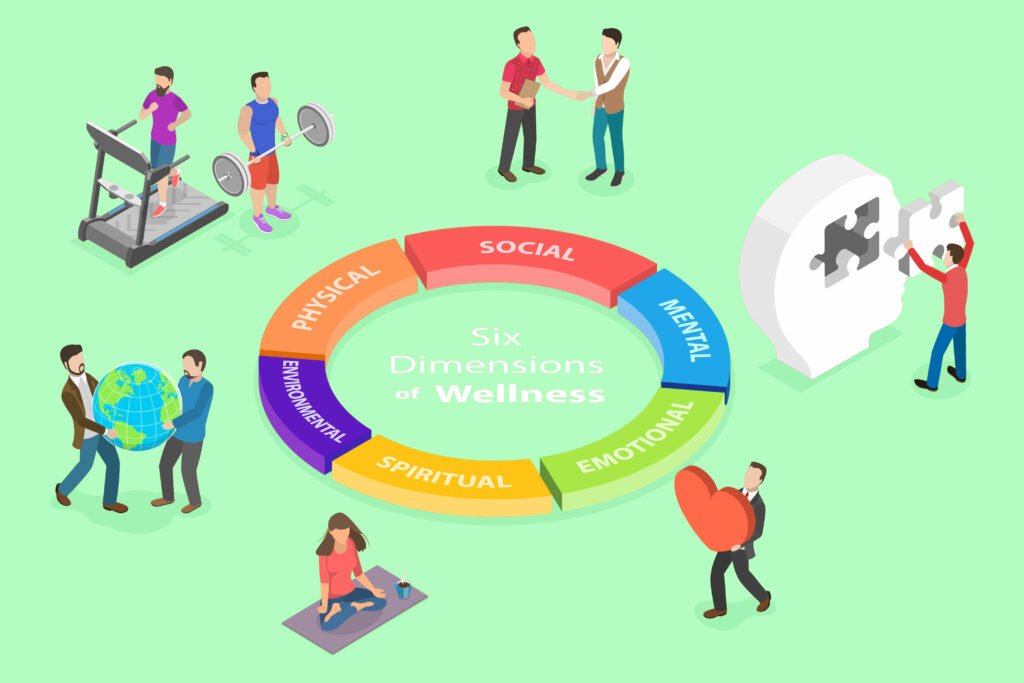The World Health Organization defines health as “A state of complete physical, mental and social well-being and not merely the absence of disease or infirmity.” Different definitions have been employed over time for various objectives. Promoting health can be done by encouraging healthy behaviors like regular exercise, getting enough sleep, and minimizing or avoiding unhealthy behaviors.
According to the National Wellness Institute, there are six dimensions of wellness divided into emotional, occupational, physical, social, intellectual, and spiritual. We can create a holistic sense of fulfillment by addressing all six dimensions of wellness in our lives. Here we are going to walk you through each dimension.
Six Aspects of Health to Know Of
Developed by Dr. Bill Hettler, this interdependent model, commonly referred to as the Six Dimensions of Wellness, provides the categories from which the National Wellness Institute derives its resources and services. Let’s know more about each:
1. Occupational
The occupational dimension acknowledges the fulfillment and richness that work brings to a person’s life. The fundamental tenet of occupational well-being is that professional advancement is correlated with one’s attitude toward one’s career.
This dimension follows:
- Choosing a career that aligns with our values, interests, and beliefs is preferable to choose one that we find unfulfilling.
- Developing practical, transferable skills through organized involvement opportunities is preferable to staying inactive and uninvolved.
2. Physical
Physical well-being is achieved by combining exercise with healthy dietary practices. It requires diligence and accountability on your part.
This dimension follows the philosophy of:
- It is preferable to consume foods and beverages that promote excellent health instead of those that harm it.
- Being physically fit is preferable to being out of shape.
3. Social
The social dimension promotes giving back to one’s surroundings and community. It highlights how interconnected people and nature are. And how actions affect the ones that surround us.
This dimension follows the philosophy of:
- It is better to contribute to the general welfare of our community than to think solely of ourselves, according to the following beliefs of social well-being.
- Living in conflict with others or our environment is preferable to living in harmony with them.
4. Intellectual
The intellectual dimension acknowledges one’s imaginative and engaging mental activity. Healthy individuals discover the opportunity to share their gifts with others while expanding their knowledge and abilities.
This dimension follows:
- Engaging in intellectual and creative activities that expand and push our thoughts is preferable to being self-satisfied and ineffective.
- Identifying possible issues and selecting the best course of action based on the knowledge at hand is preferable to waiting, worrying, and dealing with significant problems in the future.
5. Spiritual
The spiritual component acknowledges our yearning for significance and meaning in life. It involves gaining a profound understanding of life’s breadth, depth, and natural forces in the cosmos.
The spiritual dimension follows:
- Instead of closing our minds and becoming intolerant, it is preferable to reflect on the meaning of life for ourselves and be respectful of other people’s opinions.
- It is preferable to live each day according to our values and beliefs rather than to act otherwise and experience self-doubt.
6. Emotional
The emotional dimension values emotional awareness and acceptance. The level of optimism and happiness one experiences toward themselves and life is a key component of emotional wellness. It encompasses the ability to control one’s emotions and associated behaviors, such as a realistic assessment of one’s capabilities, the growth of one’s independence, and the ability to cope effectively with stress.
This dimension follows:
- It is preferable to acknowledge and accept our emotions than to suppress them.
- Being upbeat about life is preferable to being downhearted.
Applying the Six Dimensions of Wellness Model
By applying the model of the six dimensions, a person becomes aware that all dimensions are connected and how using them can lead to a healthy life.
Practically every human effort can benefit from the use of a wellness strategy. One can make better decisions about incorporating health into daily life by learning about the Six Dimensions of Health. The use of wellness methods is a practical strategy to begin forming good habits that can improve physical and mental health.
Your Path to Preventative Care in One Place
Knowing and recognizing the six dimensions of wellness for healthy living is important. Most of the time, we only focus on the well-being of our physical body, but we tend to neglect other aspects that affect our way of living.
At HCRpath, we provide easy-to-use digital wellness screening software to help seniors, healthcare providers, and caregivers to connect. If your organization or practice would like to get a demo of HCRpath or start using it right away, please get in touch with us at info@hcrpath.com.






